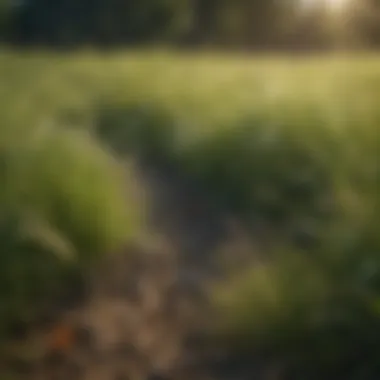Understanding Dormant Grass: Key Characteristics & Management


Intro
Understanding dormant grass is essential for those engaged in lawn care, agriculture, and environmental conservation. This state of dormancy occurs when grasses face adverse conditions, such as drought or extreme cold, resulting in a temporary pause in growth. Recognizing the characteristics of dormant grass and effective management techniques can significantly impact land use and ecosystem sustainability. It is necessary to examine the biological processes behind dormancy and its practical implications.
Topic Overview
Definition and Importance
Dormant grass refers to the phase where grasses become inactive, conserving resources in response to stressors. This process helps grasses survive unfavorable conditions. The importance of understanding dormant grass lies in the ability to implement appropriate care strategies suitable for varying weather patterns and environmental stresses. When grasses enter dormancy, knowing how to manage them can maintain lawn appearances and improve soil quality.
Brief History and Evolution
Historically, grasses have adapted to survive through periods of dormancy. Wild grasses evolved to thrive in regions with seasonal changes, developing dormancy mechanisms to withstand harsh climates. From early agricultural practices, where grassland management was essential to supporting livestock, to the modern-day focus on lawn aesthetics, understanding dormancy has evolved into a critical aspect of both agricultural practices and landscaping.
Key Techniques and Innovations
Sustainable Farming Practices
Implementing sustainable practices is integral in managing dormant grass. Some techniques include:
- Crop rotation: Using different types of grasses or crops helps maintain soil fertility by preventing nutrient depletion.
- Minimal tillage: Reducing soil disturbance preserves its structure, helping retain moisture during dormant periods.
- Cover cropping: Planting cover crops during off-seasons protects soil and enhances nutrient cycling.
Advanced Agronomic Technologies
Technological advancements have transformed grass management. Tools that help monitor soil conditions, water usage, and nutrient levels enable educated decision-making regarding dormant grass care. Precision agriculture, for instance, uses satellite imagery and GPS technology to provide data-driven insights into grass health.
Practical Applications
Step-by-Step Guides
- Assess grass condition: Identify if the grass has entered dormancy due to lack of water or other stressors.
- Adjust watering schedules: During dormancy, reduce watering to prevent waste and encourage deeper root growth once conditions improve.
- Avoid heavy fertilization: Provide modest amounts of nutrients, since grasses are not actively growing.
- Monitor recovery: As conditions improve, increase watering gradually and fertilize appropriately to stimulate growth.
Case Studies or Real-World Examples
Analyzing successful grass management during dormancy fosters a better understanding. For instance, in regions experiencing recurrent droughts, farmers have documented how switching to drought-resistant grass types has led to successful lawn maintenance, even during extreme conditions. These case studies highlight the significance of both adaptability and knowledge in grass management.
"Understanding the seasonal behavior of grass can significantly impact agricultural productivity and environmental outcomes."
Defining Dormant Grass
Understanding dormant grass is key for both enthusiasts and practitioners in the field of agriculture. This concept plays a significant role in effective lawn care and sustainable practices. When grass enters dormancy, it is crucial to recognize its characteristics and management needs. This understanding leads to better maintenance strategies that align with the grass's natural growth cycles. This article will unfold the biological explanation, the specific types of grasses that can go dormant, and the implications of dormancy on grass health.
Biological Basis of Dormancy
The biological basis of dormancy in grasses involves a complex interplay of environmental factors. Dormancy usually occurs in response to stressors like extreme heat or cold, as well as water scarcity. During dormancy, grass shifts its metabolic processes to conserve resources. This ensures survival during unfavorable conditions. Grasses possess certain mechanisms that enable them to not just withstand adverse environmental stress, but thrive following a recovery period. Understanding these processes is crucial for implementing effective grass management strategies.
Types of Grass that Can Enter Dormancy
Grasses can be categorized into two primary types based on their growth patterns: cool-season grasses and warm-season grasses. Each type has its unique characteristics, enabling different adaptation mechanisms during periods of dormancy.
Cool-season grasses
Cool-season grasses, such as Kentucky bluegrass and fescue, typically thrive in temperate climates. These species enter dormancy during extreme summer conditions. A key characteristic of cool-season grasses is their growth cycle, which peaks in the cooler months of spring and fall. This trait allows them to conserve moisture and energy when temperatures soar. As a result, they are popular among homeowners for their vibrant green hues during the growing season. However, during hot summers, they may exhibit signs of dormancy, potentially detracting from lawn aesthetics.
Warm-season grasses


Warm-season grasses, including Bermudagrass and Zoysiagrass, are adapted to thrive in higher temperatures and abundant sunlight. These grasses enter dormancy in cooler temperatures, typically during the winter months. A key feature of warm-season grasses is their vigorous growth during the summer, making them ideal for regions where heat is prominent. They are favored in southern climates due to their drought resistance and low maintenance. However, while they are hardy in summer, their dormancy period may lead to brown patches in lawns, which can be a concern for maintenance and appearance.
Understanding these grass types allows for better planning and management of lawns, ensuring that the specific characteristics of cool-season and warm-season grasses are leveraged for optimal growth and sustainability.
Reasons Grass Becomes Dormant
Understanding why grass enters a dormant state is crucial for effective management and maintenance of healthy grass systems. Dormancy can occur due to various environmental factors, each playing a significant role in grass health. Knowing these factors allows one to make informed decisions about when to intervene and how to maintain grass vigor during dormant phases.
Seasonal Changes
Seasonal changes are a primary cause of grass dormancy. Cool-season grasses, like Kentucky bluegrass, often enter dormancy during extremely hot summer months. On the other hand, warm-season grasses, such as Bermuda, may experience dormancy during winter. This adaptation helps grasses conserve resources during periods when environmental conditions are not favorable for growth.
As temperatures rise or drop significantly, the grass recognizes these changes through internal mechanisms that trigger dormancy. Factors such as reduced daylight and lower soil temperatures also play a role in signaling these seasonal transitions. The biological process is essential for long-term survival, allowing grasses to withstand adverse conditions until more favorable growth conditions return.
Water Stress and Drought Conditions
Water stress and drought conditions directly affect grass health, leading to dormancy as a survival strategy. When soil moisture decreases, the grass adapts by slowing down its metabolic processes. This helps conserve energy and prevent damage to vital systems. In areas that experience low rainfall or prolonged drought events, the grass plant can enter dormancy to survive these challenging conditions.
Maintaining proper irrigation is essential in combatting these stresses. Over time, irrigation practices need to be adjusted to ensure that grass receives adequate moisture without becoming overly dependent on water inputs. This balance supports growth during active phases while minimizing stress during dormancy.
Temperature Extremes
Temperature extremes are another significant reason grass may go dormant. Grasses have specific temperature thresholds for optimal growth. When temperatures reach extremes, whether too hot or too cold, the grass may respond by entering a dormant state.
For instance, when the ground becomes locked in frost or ice, cool-season grasses may halt growth entirely. Similarly, warm-season grasses may suffer from heat stress during incessant warm periods, leading them to go dormant to protect themselves.
Managing these temperature extremes requires understanding the specific type of grass in question. Proper cultural practices can mitigate stress during these extremes, such as selecting appropriate species for the local climate and ensuring that soil health is maintained for nutrient availability.
The ability of grass to go dormant is a strategic response to environmental conditions, allowing species to survive under less than favorable circumstances.
Identifying Dormant Grass
Identifying dormant grass plays a crucial role in understanding the health and management of a lawn or pasture. Recognizing the signs of dormancy helps differentiate between grass that is resting and grass that may be unhealthy or dead. This knowledge is essential for both farmers and lawn enthusiasts, as it influences decisions on watering, fertilizing, and overall care. A proactive approach can significantly improve grass recovery when environmental conditions become favorable.
Physical Appearance During Dormancy
Dormant grass exhibits distinct physical traits that indicate its state. The most noticeable characteristic is color. Healthy grass tends to be vibrant green, while dormant grass can take on a brownish or yellow hue. This discoloration happens because the grass reduces chlorophyll production, conserving energy during stressful conditions. Additionally, the leaves of dormant grass may curl or appear dry, giving a parched appearance.
Another feature is the texture. Dormant grass can feel brittle to the touch. These changes are not signs of permanent damage but rather adaptations to survive harsh conditions such as heat and drought. By noticing these attributes, one can easily determine if the grass is in a dormant state and consider suitable management practices to help it revive when conditions improve.
Soil Conditions and Grass Health Indicators
Soil conditions provide key insights into grass health, particularly during dormancy. Soil moisture levels are critical; dry soil can indicate that the grass is experiencing water stress. Conducting a simple test, like checking the soil's ability to retain moisture, can help determine if irrigation is warranted.
Furthermore, soil temperature affects dormancy. Cool soils can slow down or halt growth, while excessively warm soils might exacerbate dormancy. It is advisable to monitor these conditions closely.
Health indicators of the grass itself also reside in the soil. A flourishing ecosystem, rich in earthworms and microorganisms, may suggest a healthier environment conducive to grass recovery. Conversely, soil compaction can hinder root development and water absorption, leaving the grass more vulnerable to dormancy.
In summary, identifying dormant grass relies on both visible traits and soil health. Understanding these elements provides a solid foundation for effective management. Monitoring these factors ensures that when conditions become favorable, the grass can recover swiftly and thrive once again.
Impact of Dormancy on Grass Health
Understanding how dormancy affects grass health is crucial for anyone involved in lawn care or agriculture. When grass enters a dormant state, it undergoes significant physiological changes that affect its overall vitality. Recognizing the impact of dormancy allows for better management practices that can ultimately lead to stronger and healthier grass.
Dormancy can be a survival strategy for grass, but it comes at a cost. Grasses will conserve resources, which can lead to an unfulfilling appearance. However, the importance lies in the resilience it creates. By focusing on grass health during dormancy, one can minimize stress and optimize recovery once favorable conditions return.
Root System Dynamics


The root system of grass plays an integral role during dormancy. As the grass reduces its above-ground growth, the root system can be affected in two key ways. First, most grasses will slow down nutrient uptake. This means they are less reliant on minerals and water available in the soil. The roots may even enter a phase of inactivity to preserve energy, which can reduce their size as they adjust to the dormant state.
Moreover, the root health can indicate how well the grass will recover post-dormancy. Healthy roots can store energy more efficiently, which translates to better growth when conditions improve. Consequently, maintaining a healthy root system during dormancy can be achieved through methods like avoiding overwatering, ensuring good drainage, and ensuring proper soil aeration.
"A robust root system is essential for a grass's recovery from dormancy. Poorly managed grass with weak roots will have a harder time bouncing back."
Photosynthesis and Energy Conservation
Photosynthesis is a critical process for grass growth, and its operation changes during dormancy. In a dormant state, the grass can significantly reduce or halt photosynthesis. This is primarily due to the lack of sunlight and reduced temperatures that do not favor photosynthesis.
Energy conservation becomes more relevant at this stage. The grass attempts to preserve any energy it has, which means it will focus on essential functions only. This minimal metabolic activity allows the grass to survive in unfavorable conditions. Managing this process is crucial; applying fertilizer during dormancy is often counterproductive as the grass cannot effectively utilize these nutrients.
By understanding this phase of reduced photosynthesis, grass owners can adapt their management strategies. They can focus on factors that support overall health, such as maintaining soil quality and ensuring good aeration, thus setting the stage for the grass to bounce back once the conditions are right.
Management Strategies for Dormant Grass
Managing dormant grass is crucial for maintaining healthy ecosystems, especially in lawns and agricultural fields. Understanding how to manage grass during dormancy can lead to better conservation of resources and improved recovery during active growth phases. Proper management strategies help ensure that grass remains resilient and can withstand the challenges posed by dormancy.
Irrigation Practices During Dormancy
Irrigation plays a pivotal role in managing dormant grass. During periods of dormancy, grass experiences reduced metabolic activity, making it less tolerant to water stress. However, providing adequate moisture can influence recovery once growing conditions improve. Here are several key aspects to consider:
- Timing and Frequency: Assessing the suitability of irrigation timing is vital. In many cases, irrigating before predicted dry spells helps grass absorb water when it is most needed. It is beneficial to space out irrigation sessions to prevent soil saturation.
- Amount of Water: Applying enough water to reach the root zone is essential. Shallow irrigation may not effectively support deep-rooted grass, which can affect its ability to resume growth post-dormancy.
- Technique: Using a drip irrigation system or soaker hoses can provide efficient watering. Avoiding overhead watering limits evaporation and ensures hydration.
"Appropriate irrigation strategies are necessary to promote healthier recovery from dormancy."
Fertilization Considerations
Fertilization during dormancy requires careful planning. Grass is generally less responsive to fertilizers during its dormant phase because nutrient uptake decreases. Still, a strategic approach can yield benefits:
- Soil Testing: Conduct soil tests before applying any fertilizers. Understanding nutrient levels helps to apply the right amounts in line with the specific needs of your grass type.
- Type of Fertilizer: Opt for slow-release fertilizers, which provide nutrients gradually, minimizing the risk of nutrient leaching and maximizing efficiency. Choosing organic options can also benefit soil health long-term.
- Application Timing: Fertilizing just before the grass exits dormancy is advantageous. This ensures that when active growth resumes, sufficient nutrients are available to support recovery.
Aeration Techniques
Aeration is an essential management technique that enhances root health, particularly for dormant grass. By improving the infiltration of air, water, and nutrients into the soil, aeration can prepare the grass for revitalization:
- Core Aeration: This method involves removing cores of soil to relieve compaction. It promotes root expansion, allowing water to reach deeper layers more effectively. Core aerators can be rented or purchased from local garden centers.
- Timing and Frequency: Timing aeration correctly is essential. Late spring or early fall is often recommended since these periods align with grass recovery. Aeration during dormancy can still be effective if done in moderation and while ensuring conditions are suitable.
- Benefits of Aeration: Beyond improving nutrient uptake, aeration supports soil microbial activity and water retention. These benefits help create a conducive environment for grass recovery as temperatures rise.
In summary, understanding management strategies for dormant grass enables more effective lawn care and agricultural practices. Timely irrigation, strategic fertilization, and appropriate aeration can greatly enhance grass health and support its resilience during dormancy.
Environmental Considerations
Understanding the environmental aspects of dormant grass helps inform effective management strategies. Dormancy is not solely a biological phenomenon; it also involves the interplay between grass species and environmental factors. Recognizing these influences can lead to better practices in lawn and agricultural management.
Impact of Climate on Grass Dormancy
Climate plays an essential role in determining when and how grass goes dormant. Grass species have specific temperature and moisture thresholds that trigger dormancy. For instance, cool-season grasses typically enter dormancy during prolonged high temperatures, while warm-season varieties may go dormant in colder conditions.
Several climate-related factors impact grass dormancy:
- Temperature fluctuations: Rapid changes in temperature can induce stress, leading to dormancy.
- Precipitation levels: Low rainfall can cause drought conditions, pushing grass into a dormant state.
- Humidity: High humidity levels can inhibit the processes that grasses undergo to remain active.
In a changing climate, farmers and gardeners must be vigilant in monitoring these factors to manage grass effectively during its dormant phases. Innovative practices like drought-resistant species selection may become essential to address shifting climate patterns.
Biodiversity and Grass Ecosystems


Biodiversity in grass ecosystems supports ecological stability. Different grass species possess unique adaptations to their environments, allowing them to thrive in varying conditions. This diversity can have a considerable impact on the resilience of grasslands during dormancy periods.
Increased biodiversity facilitates:
- Soil health improvement: Diverse root systems enhance soil structure and nutrient availability.
- Pest resistance: A wider variety of grasses can deter specific pests and diseases.
- Ecosystem services: Healthy grass ecosystems provide benefits like carbon sequestration, water infiltration, and habitat for wildlife.
Promoting biodiversity in grass management practices allows for a more sustainable approach to maintaining grass health during dormancy. It helps ensure that grass ecosystems can better withstand environmental stressors, creating a more resilient agricultural or residential space.
"Biodiversity in grass systems is not merely advantageous; it is fundamental to ecological resilience."
In summary, recognizing the impact of climate and promoting biodiversity in grass ecosystems can significantly enhance management strategies for dormant grass. These considerations provide a framework to adapt to environmental challenges and ensure healthier lawn and agricultural systems.
Common Misconceptions About Dormant Grass
Understanding dormant grass is critical as many people hold misunderstandings about its characteristics and management. These misconceptions can affect how grass is cared for during periods of dormancy, potentially leading to poor health or even death of the grass. It is essential to clarify these myths to promote a healthier ecosystem and improve lawn aesthetics.
Myths Regarding Grass Recovery
One prevalent myth is that dormant grass is dead. This perspective overlooks the biological resilience of grass species as they can survive extended periods without water or nutrients. Dormancy acts as a survival mechanism during periods unfavorable for growth.
Key Points to Consider:
- Dormancy vs. Death: Grass can appear brown and lifeless during dormancy, but this does not imply that the plant is dead. Grass remains alive in the root system, ready to recover once conditions improve.
- Recovery Potential: Many homeowners assume that if grass is dormant for too long, it will not recover. However, most grasses can bounce back after dormancy ends, provided they receive adequate water and care.
If individuals recognize that dormant grass is a natural and healthy phase, they will be more patient and avoid unnecessary interventions, such as over-watering or excessive fertilization, which can harm the grass.
The Role of Dormancy in Lawn Aesthetics
Another common misconception is that dormant grass has a negative impact on the aesthetics of a lawn. While it is true that dormant grass can lose its lush green color, it still plays a valuable role in the overall health of lawn ecosystems.
Consider the Following:
- Natural Cycle: Dormancy is part of the natural life cycle of grass. Accepting this fact helps one understand that a brown lawn in winter is a physiological response to cooler temperatures and lack of water.
- Soil Health: Dormant grass often helps to retain soil moisture and prevent soil erosion during non-growing seasons. This contributes to a stable environment for future growth.
Homeowners can maintain aesthetic value by managing expectations and focusing on proper seasonal practices. Proper lawn care across different seasons, including adequate overseeding, will ensure the grass thrives when it reawakens.
"Understanding the role of grass dormancy is key to achieving a sustainable and appealing lawn."
Clarifying these misconceptions about dormant grass can lead to more informed decisions regarding lawn care. By adopting a more realistic perspective, agriculture enthusiasts and homeowners alike can promote better practices that enhance both lawn health and appearance.
End
The conclusion serves as the final synthesis of insights gathered through the exploration of dormant grass. Understanding the complexities of dormancy is essential for anyone involved in lawn care, agriculture, or environmental management. This awareness allows individuals to make informed decisions that lead to healthier grass ecosystems and sustainable practices.
In this article, we covered key points such as the biological basis of dormancy, the reasons grasses enter this state, and the management strategies available to maintain grass health during dormant periods. Each aspect is crucial because it lays the groundwork for effective grass care. Proper identification of dormancy type can prevent mismanagement. Grass types respond differently to stress factors, making targeted approaches necessary.
Furthermore, knowledge about common misconceptions helps during discussions and decisions. Many people mistakenly believe that dormant grass is dead or beyond recovery. Recognizing that dormancy is a natural process is key in achieving successful grass management.
Effective management of dormant grass leads to several benefits:
- Improved Lawn Health: Understanding dormancy aids in nurturing strong root systems and enhancing recovery when conditions become favorable.
- Resource Efficiency: Knowledge of appropriate irrigation and fertilization practices minimizes waste, benefiting both the environment and budget.
- Aesthetic Appeal: Proper management contributes to the visual quality of lawns, aligning with the needs of homeowners and agricultural standards alike.
Recap of Key Points
- Dormancy is a natural state many grass species enter during extreme environmental conditions.
- Knowledge of the biological basis and external factors influencing dormancy is invaluable for effective management.
- Misconceptions about dormant grass can lead to improper care and management decisions.
- Implementing informed management practices can ensure healthy grass ecosystems and enhance their resilience.
Future Directions in Grass Research
Future research in grass dormancy should focus on several essential areas:
- Impact of Climate Change: Understanding how changing climate patterns affect grass dormancy will be vital in adjusting management practices accordingly.
- Genetic Research: Investigating genetic variations in grasses may lead to the development of varieties that are more resilient to drought and temperature extremes.
- Technological Advancements: Using technology for monitoring grass health and dormancy could revolutionize lawn management, allowing for precise irrigation and nutrient application.
- Sustainable Practices: Research into organic and sustainable practices could offer better solutions for managing dormant grass while minimizing ecological impact.
By prioritizing these areas, we can improve grass management strategies, ensuring sustainable practices are integrated into everyday care routines.



